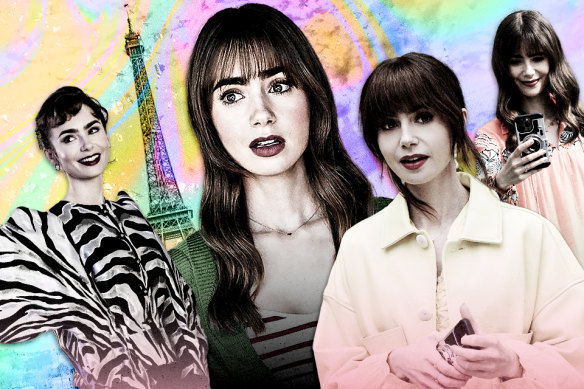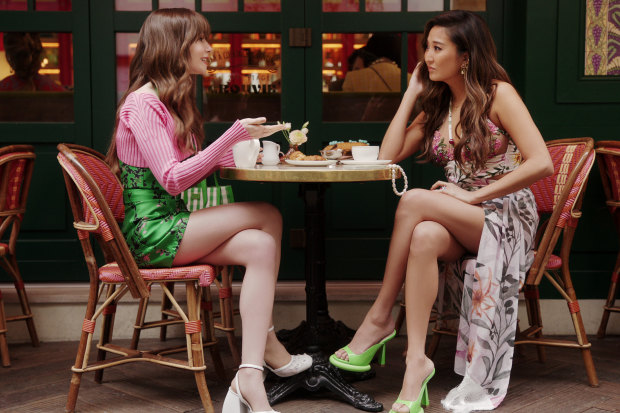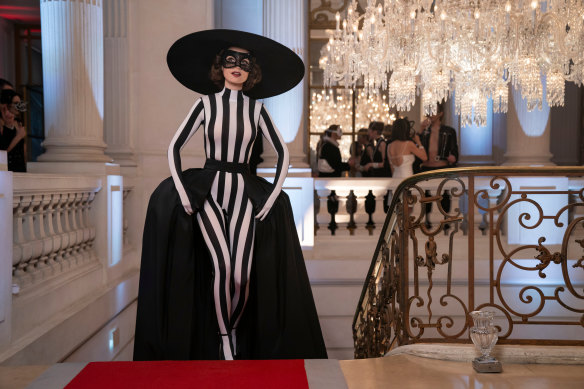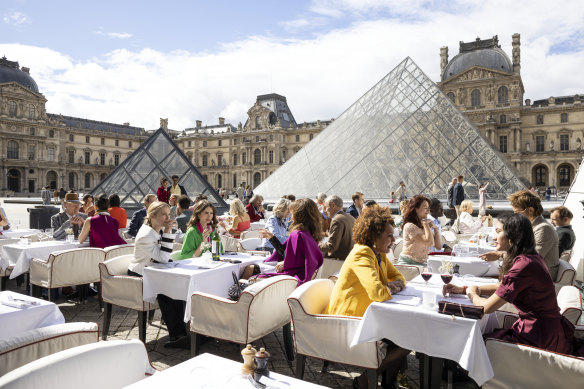This was published 7 months ago
Je l’adore, je la deteste: The Emily in Paris debate
By Thomas Mitchell and Louise Rugendyke

Lily Collins is Emily in Paris. Credit: Aresna Villanueva
Ludicrous candy floss, or light entertainment at its finest? Somehow Emily in Paris has been sparking lively debate since Lily Collins’ fashionably attired ingenue first walked into her dream job in the French capital. Now embarking on its fourth season, we asked two of our critics to explain how they really feel about Emily.
The case for Emily
Yes, Emily in Paris is ridiculous. A cream puff of a show – the profiterole of streaming – with rampant product placement and an optimist’s view of Paris. But who cares? It’s supposed to be light as air, a Parisienne postcard where women take the lead. And that’s what makes it a target.
It’s the usual sexist nonsense: shows aimed at women – and yep, blokes are free to enjoy them as well – are held to a higher standard and more criticism than shows appealing to men or a broader audience. I could get into an argument here about how that’s reflective, generally of women at home, in the workplace, in politics and in high-profile jobs, but today, I’ll just stick to the TV show.

Lily Collins and Ashley Park in the fourth season of Emily in Paris: what’s wrong with fantasy?Credit: Netflix
OK, so Emily in Paris is so fake, I hear you say because there is no way she would live in an apartment like that with so many clothes. Yeah, yeah, we’ve heard it all before with Sex and the City. Well, guess what? Dragons are fake, and I don’t hear anyone taking issue with that in House of the Dragon or Game of Thrones.
Oh, what’s that? They’re fantasy and not supposed to be realistic? Right, so it’s OK to have the walking dead, bad wigs and incest in a show with dragons, but somehow Emily in Paris is worthy of a hate crime because she twitters around Paris, speaking English while wearing berets and boots that don’t get stuck in the cobblestones.
Give me a break. Just because Emily in Paris looks easy and is breezy doesn’t mean it’s worth less. It’s tackled not only sexual harassment in the workplace but a woman’s right to wear what she pleases (“I will not be slut-shamed,” says Mindy when she finds out her boyfriend is trying to put her in more demure clothes) and the difficulty of juggling work and family.
And while the fourth season is by no means perfect, with Emily and Gabriel still swooning over each other, did anyone complain that in Succession, Kendall spent four seasons going in circles as he tried to take over his father’s company? No, they didn’t. They gave it 13 Emmys and called it the greatest show of all time. Season four of Only Murders in the Building? Hate to break it to you, but there’s another murder. In a building.

This Audrey Hepburn-inspired ensemble is one of the highlights of the season.Credit: STEPHANIE BRANCHU/NETFLIX
On the great fromage board of streaming, there is room for all tastes, sizes, and shapes. Emily is a Brillat-Savarin triple-cream brie that happily exists with a semi-hard sheep’s milk cheese (Shogun) or a tart wedge of blue cheese (Baby Reindeer). Wash them all down with a glass of Champere Champagne from Camille’s family vineyard, and you’re good to go.
Just remember, the show is a fantasy. Paris is a fantasy. No city that included a threesome, multiple headless Marie Antoinettes and Celine Dion singing from atop the Eiffel Tower in their Olympic opening ceremony could possibly be real.
And if we didn’t have fantasies in our life, something to dream about, something to cling onto when your husband wants to watch Chimp Crazy, what are we doing? Emily is joy, Emily is life, Emily is right there in Latin on the Paris coat of arms: Fluctuat nec Mergitur. She is rocked by the waves but does not sink. Vive la Emily. Louise Rugendyke
The case against Emily
There is a moment early in the fourth season of Emily in Paris when Camille, the sometimes-friend of the titular Emily Cooper (Lily Collins), goes on the run, whereabouts unknown. There is some speculation she may be in Greece or hiding out at her parent’s place in the south of France. At one point, Camille’s friends even suggest to Emily that she may be involved in Camille’s disappearance. “You don’t actually think that?” exclaims a shocked Emily.
Could Phil Collins’ daughter be capable of murder? Possibly. Would Emily in Prison be a more interesting show? Definitely. Anyway, it soon becomes clear that pretty much every character is concerned, and I suppose we are meant to worry, too. For a show that once dedicated an entire episode to the launch of the McBaguette, a missing person is a big deal (and a big narrative step forward).
However, watching this all play out, I only felt a surge of relief for Camille. Finally, someone trapped in Darren Star’s highly sanitised Parisian wet dream had seen the light and made a run for it. With any luck, Camille’s bravery would trigger an uprising, and the rest of the cast would join her in hiding. You know, vive la revolution and all that.
To hate on Emily in Paris has become a sport of sorts, but let me go on record as saying I didn’t always feel this way. The show’s initial explosion during the pandemic made sense to me in a way that few things did at that time. It was pure escapism featuring beautiful people in a postcard version of Paris. What’s not to love?

In case you didn’t know, this show is set in Paris.Credit: Netflix
For a while, it was fun to watch Emily performatively wear a beret and relish the fact that she can’t speak the language. But after three seasons – with a fourth recently landing on Netflix – the “so bad it’s good” factor has descended into so bad, it’s embarrassing.
Defenders of the show regularly point out that this is light entertainment, a guilty pleasure designed to make you switch off rather than switch on. The Paris that Emily inhabits is not one of makeshift refugee camps, soaring crime rates, and political tension — and that’s OK.
However, for light entertainment to continue being light and entertaining, things actually have to happen, and therein lies the great downfall of Emily in Paris. Four seasons in, each episode is a copy and paste of the previous one. Emily is still in Paris; she still manages to solve any work crisis by coming up with a pithy hashtag, and she’s still torn between Gabriel, the hot Gallic chef, and Alfie, the hot English whatever-his-job-is.
Worse still is the show’s increasing desire to abandon what once made it watchable. At first, the joke was on Emily, a brash American whose primary point of reference for her new hometown was the film, Ratatouille.
She would ping-pong from one crisis to another in a series of insane outfits while one of her co-workers, usually Emily’s oh-so-French boss, Sylvie, said what we were all thinking: “What is the point of an American who doesn’t speak French working at a Parisian marketing firm?”
Now Emily is a force to be reckoned with, and everyone loves her. The men? Adore her. Clients? Think she’s a genius. Co-workers? Emily is our favourite: the kooky American!
Whatever minimal tension that made the series binge-worthy has been extinguished, replaced by a flat, hollow shell of a show: American girl lives an amazing life in Paris and has many clothes.
You know, the French have a famous proverb, Mieux vaut etre seul que mal accompagne, or “Better to be alone than in bad company”. After four seasons of hanging out with Emily in Paris, I finally understand what they mean (and so, too, it seems, does Camille). Thomas Mitchell
Find out the next TV, streaming series and movies to add to your must-sees. Get The Watchlist delivered every Thursday.